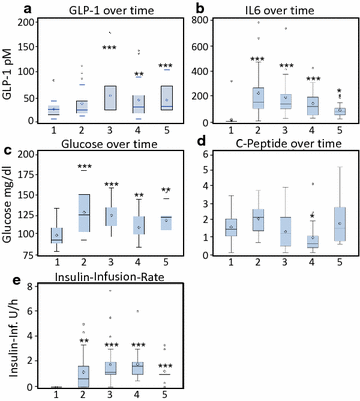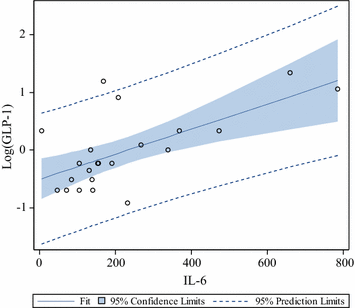Interleukin-6 predicts inflammation-induced increase of Glucagon-like peptide-1 in humans in response to cardiac surgery with association to parameters of glucose metabolism
- PMID: 26842302
- PMCID: PMC4739342
- DOI: 10.1186/s12933-016-0330-8
Interleukin-6 predicts inflammation-induced increase of Glucagon-like peptide-1 in humans in response to cardiac surgery with association to parameters of glucose metabolism
Abstract
Objective: Glucagon-like peptide-1 (GLP-1) is an incretin hormone, which gets secreted in response to nutritional stimuli from the gut mediating glucose-dependent insulin secretion. Interestingly, GLP-1 was recently found to be also increased in response to inflammatory stimuli in an interleukin 6 (IL-6) dependent manner in mice. The relevance of this finding to humans is unknown but has been suggested by the presence of high circulating GLP-1 levels in critically ill patients that correlated with markers of inflammation. This study was performed to elucidate, whether a direct link exists between inflammation and GLP-1 secretion in humans.
Research design and methods: We enrolled 22 non-diabetic patients scheduled for cardiac surgery as a reproducible inflammatory stimulus with repeated blood sampling before and after surgery.
Results: Mean total circulating GLP-1 levels significantly increased in response to surgery from 25.5 ± 15.6 pM to 51.9 ± 42.7 pM which was not found in a control population. This was preceded by an early rise of IL6, which was significantly associated with GLP-1 under inflammatory but not basal conditions. Using repeated measure ANCOVA, IL6 best predicted the observed kinetics of GLP-1, followed by blood glucose concentrations and cortisol plasma levels. Furthermore, GLP-1 plasma concentrations significantly predicted endogenous insulin production as assessed by C-peptide concentrations over time, while an inverse association was found for insulin infusion rate.
Conclusion: We found GLP-1 secretion to be increased in response to inflammatory stimuli in humans, which was associated to parameters of glucose metabolism and best predicted by IL6.
Figures


References
-
- Yelich MR, Filkins JP. Mechanism of hyperinsulinemia in endotoxicosis. Am J Physiol. 1980;239(2):E156–E161. - PubMed
Publication types
MeSH terms
Substances
LinkOut - more resources
Full Text Sources
Other Literature Sources
Medical

